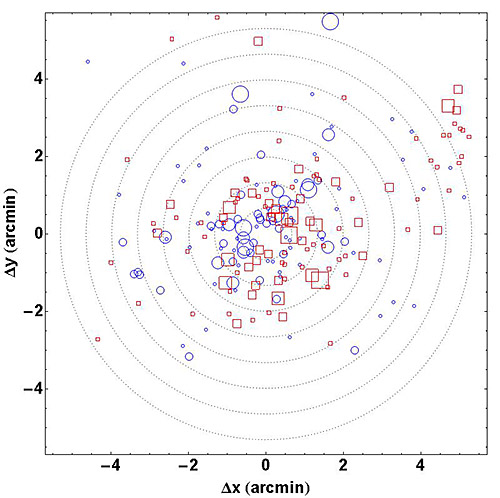ING web news release
28 December, 2016
A Deficit of Dark Matter in Elliptical Galaxies
The 'missing mass problem' is a long-standing issue in astrophysics, being present in galaxies, cluster of galaxies and even at the cosmological scale. Astronomers from Taiwan have used archival data from PN.S and SAURON to study the internal dynamics of seven nearby elliptical galaxies, and report finding a dearth of dark matter. They conclude that the dynamics of these galaxies are well explained by MOdified Newtonian Dynamics (MOND).
In the dark matter halo scenario, one expects that close to the centre
of a galaxy ordinary matter dominates dark matter, while at large
distances from the centre dark matter becomes dominant. Thus
measurement of the dynamics at the outskirts of galaxies is crucial
to the dark matter scenario. As an alternative to the dark matter scenario,
MOND predicts the dynamics at the outskirts solely from the ordinary, luminous
matter of the galaxy.
Elliptical galaxies commonly have their stars concentrated at the centre, and gas content is low. This makes the study of dynamics by stars at large distance from the centre very difficult.
Due to their strong emission lines, Planetary Nebulae (PNe) are potentially good probes for studying the kinematics and dynamics at the outskirts of elliptical galaxies.
The Planetary Nebulae Spectrograph (PN.S) on the William Herschel Telescope (WHT) can detect and measure the velocity of PNe, and in recent years has been obtaining velocity measurements of several hundreds of PNe in several nearby galaxies (see Figure 1).
|
 |
The line-of-sight velocity distribution of 214 PNe in the NGC 3379 galaxy relative to the centre. Circles represent receding PNe and boxes approaching PNe. Dotted circles denote distance from the centre of the galaxy in units of one effective radius. Velocity is proportional to the symbol size, and ranges from -400 to +400 km/s -1. Credit: Yong Tian.
Large format: JPEG.
|
The first results of the analysis of the observations were reported by Romanowsky et al. in 2003. They found a 'dearth' of dark matter in three elliptical galaxies and that the data are modelled well by Newtonian dynamics. However, the 'lack of dark matter' in these galaxies can
be explained by another view of the 'missing mass problem' — MOND.
The 'missing mass problem' is, in fact, the mismatch between
the measured gravitational acceleration and the inferred Newtonian
gravitational acceleration produced by the observed luminous matter of the system. The mismatch can be accounted for by
the existence of non-luminous matter ('dark matter'), a modified
law of inertia or a modified theory of gravity. The latter was proposed in the 80s as a modification of Newton's second law when the
acceleration is smaller than a small constant, a0=1.2x10-10 m/s2.
Milgrom & Sanders (2003) showed that the luminous elliptical galaxies
reported by Romanowsky et al. can be well explained by MOND. They pointed out that
in MOND the acceleration discrepancy is small in these
systems.
With refined stellar and planetary nebula velocity measurements obtained using the SAURON integral-field spectrograph and PN.S on the WHT, the Romanowsky sample could be enlarged to seven elliptical galaxies.
Tian and Ko (2016) find that, again, all galaxies in the new sample have a
deficit of dark matter. The data can be fit by adding a singular isothermal
dark matter halo but the required amount of dark matter does not dominate
the mass in the halos, contrary to expectation. They show, however, that
MOND naturally explains the dynamics of these seven galaxies out to six
effective radii.
More information:
- Milgrom M., Sanders R. H., 2003, "Modified Newtonian Dynamics and the ``Dearth of Dark Matter in Ordinary Elliptical Galaxies", ApJ, 599, L25 [ ADS ].
-
Romanowsky et al., 2003, "A Dearth of Dark Matter in Ordinary Elliptical Galaxies", Science, 301, 1696 [ ADS ].
-
Yong Tian, and Chung-Ming Ko, 2016, "Dynamics of elliptical galaxies with planetary nebulae in modified Newtonian dynamics", MNRAS, 462, 1092 [ ADS ].
-
Planetary Nebula Spectrograph (PN.S) web site.
-
SAURON web site.
|
|



